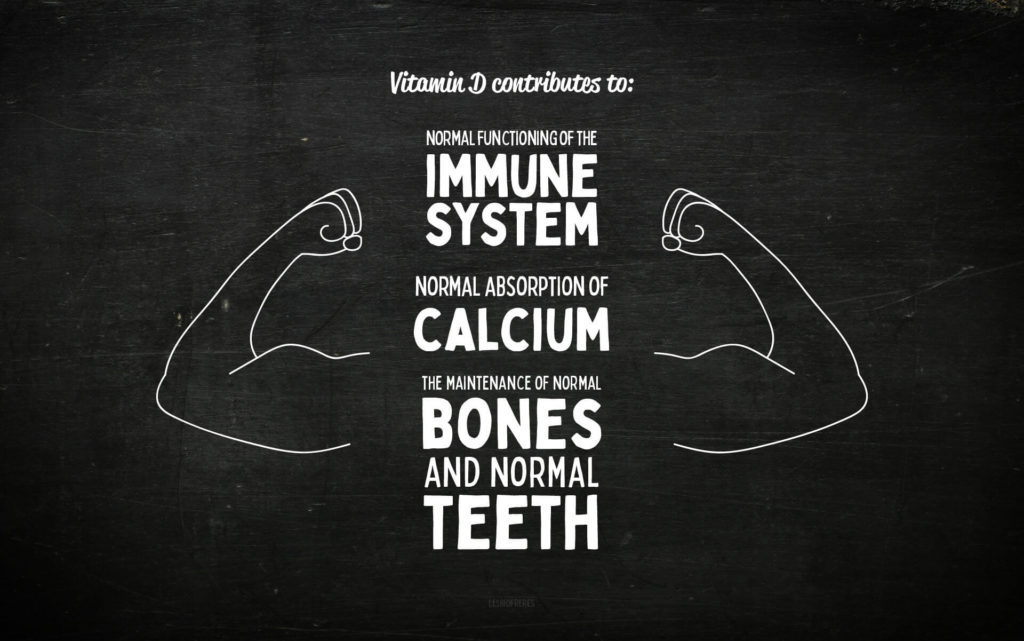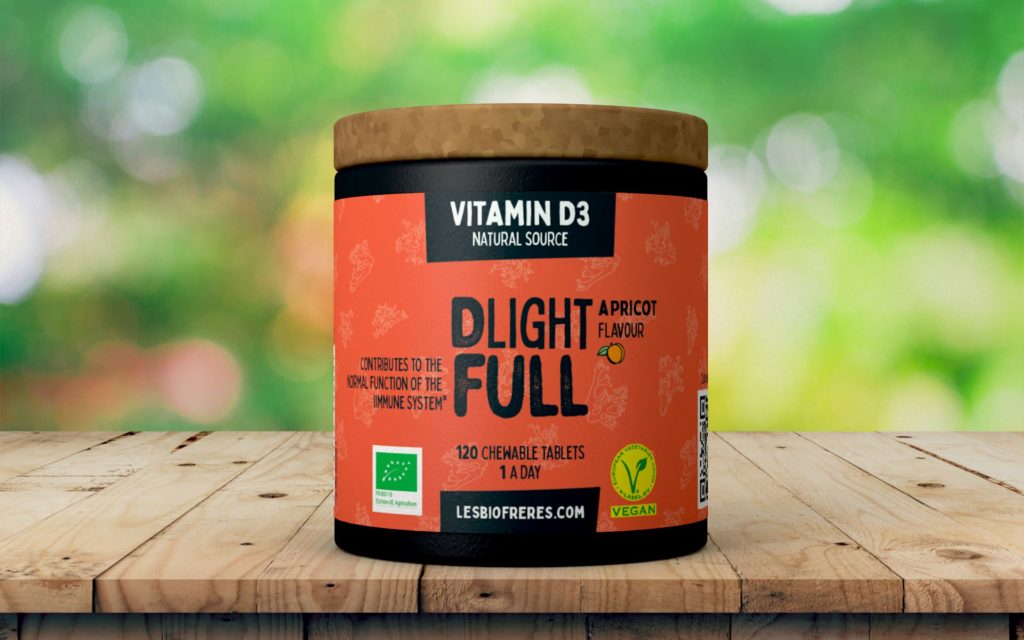Vitamin D: everything you always wanted to know but were afraid to ask
Reading time: 6 minutes | Written with love by: Alexis
Vitamin D, its benefits on the body, the signs of a lack, the different forms... Follow the guide, Alexis tells you everything.

What is Vitamin D?
Vitamin D is the generic term for both vitamin D2 and vitamin D3.
They are also known as ergocalciferol (Vit D2) and cholecalciferol (Vit D3) for the purists. Both are synthesised by exposure to UVB rays from the sun: in plants and fungi for vitamin D2, and in human and animal skin for vitamin D3.
There are therefore two main sources of vitamin D:
diet and exposure to the sun.
What are the benefits of vitamin D?
The major biological function of the active form of vitamin D is to maintain calcium and phosphorus homeostasis, which is essential for bone mineralisation (1) and neuromuscular function (2) (it’s basically good for your bones and muscles).
However, the vitamin D receptor is expressed in virtually every cell in the human body (3) suggesting that it may play a much more important role in many biological processes.
What are the signs of vitamin D deficiency?
And yes, a vitamin D deficiency affects the body, as vitamin D contributes to:
- normal function of the immune system
- normal absorption of calcium and phosphorus
- the maintenance of normal bones and normal teeth
Deficiency is defined as concentrations of the active form of vitamin D below 25 nM/l in the blood. (5).
What is the difference between vitamin D2 and vitamin D3 ?
The chemical structures of vitamins D2 and D3 are similar but not identical, there is a double bond and an extra methyl group for D3 ;).
Whatever their source, vitamins D2 and D3 will undergo the same metabolic process, and will eventually be converted to active forms in the kidney. Historically, vitamins D2 and D3 were considered to be equally efficient in being converted to the active form (8).
Since the 1980s, evidence for the efficiency of vitamin D3 has been confirmed by a significant number of clinical trials, including randomised controlled trials (9 to 24).
That’s why we’ve formulated our organic Dlightful with vitamin D3.
Where to find vitamin D in food?
Vitamin D2 is mainly found in plants and vitamin D3 mainly in animal sources (not for us animal lovers). There is, however, one source of plant vitamin D3: lichen .

What is Lichen ?
A lichen is not a single organism. It is a symbiosis between a fungus and an alga. These two organisms live as one unit. Lichen is often found growing on rocks, trees or wood. There are over 18,000 species worldwide and some colonies are estimated to be over 9,000 years old!
They should not be eaten directly as many species are poisonous, there are only a few that are edible. In other words, don’t go picking them while you are on a walk!
Which Lichen is in our Dlightful?
Our producer collects the species called Cladonia rangiferina from the wild. It is also known as reindeer lichen, as it is a vital source of food for reindeer.
The lichen is collected in the wild by hand from January to March.
Dietary recommendations for vitamin D
The NHS recommends that children from the age of 1 year and adults need 10 micrograms (μg) of vitamin D a day. This includes pregnant and breastfeeding women, and people at risk of vitamin D deficiency (more information here). During the autumn and winter, you need to get vitamin D from your diet because the sun is not strong enough for the body to make vitamin D.
One tablet of Organic Dlightful therefore provides an average of 100% of the daily allowance of vitamin D3, i.e. 10 µg or 400 IU!
Do not exceed the recommended daily dose!
An overdose of vitamin D can cause an abnormal and permanent rise in the level of calcium in the blood, which can lead to nausea, headaches, muscle and bone pain, heart rhythm problems, and calcium deposits in the kidneys, blood vessels, heart and lungs. Serious and life-threatening kidney problems can occur.
But don’t worry!
These side effects occur as soon as the daily intake exceeds 50,000 IU, which corresponds to 1.25 mg per day. Even prolonged exposure to the sun in summer does not result in such a high blood concentration!
So don’t worry about our organic vitamin D, Dlightful, because even if you take 2 tablets a day, the dosage would be 20 µg or 800 IU, which is a long way from the 50,000 IU.
Apricot flavour organic Dlightful

If you want to stay just peachy, go for our apricot flavour Organic Dlightful: We recommend our plant based vitamin D3 supplement for people who need to reinforce their immune defences outside the summer, people who do little outdoor activity in the sunshine and people who have a vegetarian or vegan diet.
Discover Vitamin Dlightful from the Bio Frères
Sources
1. DeLuca HF (2004) Overview of general physiologic features and functions of vitamin D. Am J Clin Nutr 80, 1689S–1696S.
2. Holick MF, Binkley NC, Bischoff-Ferrari HA et al. (2011) Evaluation, treatment, and prevention of vitamin D deficiency: an Endocrine Society clinical practice guideline. J Clin Endocrinol Metab 96, 1911–1930.
3. Norman AW (2008) From vitamin D to hormone D: fundamentals of the vitamin D endocrine system essential for good health. Am J Clin Nutr 88, 491S–499S.
4. Autier P, Boniol M, Pizot C et al. (2014) Vitamin D status and ill health: a systematic review. Lancet Diab Endocrinol 2, 76–89.
5. Spiro A & Buttriss JL (2014) Vitamin D: an overview of vitamin D status and intake in Europe. Nutr Bull 39, 322–350
6. Scientific Advisory Committee on Nutrition (2016) Vitamin D and Health Report. London: The Stationary Office.
7. Spiro A & Buttriss JL (2014) Vitamin D: an overview of vitamin D status and intake in Europe. Nutr Bull 39, 322–350.
8. Park EA (1940) The therapy of rickets. J Am Med Assoc 115, 370–379.
9. Armas LA, Hollis BW & Heaney RP (2004) Vitamin D2 is much less effective than vitamin D3 in humans. J Clin Endocrinol Metab 89, 5387–5391.
10. Binkley N, Gemar D, Engelke J et al. (2011) Evaluation of ergocalciferol or cholecalciferol dosing, 1,600 IU daily or 50,000 IU monthly in older adults. J Clin Endocrinol Metab 96, 981–988.
11. Cipriani C, Romagnoli E, Pepe J et al. (2013) Long-term bioavailability after a single oral or intramuscular administration of 600,000 IU of ergocalciferol or cholecalciferol: implications for treatment and prophylaxis. J Clin Endocrinol Metab 98, 2709–2715.
12. Glendenning P, Chew GT, Seymour HM et al. (2009) Serum 25-hydroxyvitamin D levels in vitamin D-insufficient hip fracture patients after supplementation with ergocalciferol and cholecalciferol. Bone 45, 870 – 875.
13. Heaney RP, Recker RR, Grote J et al. (2011) Vitamin D3 is more potent than vitamin D2 in humans. J Clin Endocrinol Metab 96, E447–E452.
14. Itkonen ST, Skaffari E, Saaristo P et al. (2016) Effects of vitamin D 2-fortified bread v. supplementation with vitamin D2 or D3 on serum 25-hydroxyvitamin D metabolites: an 8-week randomised-controlled trial in young adult Finnish women. Br J Nutr 115, 1232–1239.
15. Lehmann U, Hirche F, Stangl GI et al. (2013) Bioavailability of vitamin D2 and D3 in healthy volunteers, a randomized placebo-controlled trial. J Clin Endocrinol Metab 98, 4339–4345.
16. Leventis P & Kiely PDW (2009) The tolerability and biochemical effects of high‐dose bolus vitamin D2 and D3 supplementation in patients with vitamin D insufficiency. Scand J Rheumatol 38, 149–153.
17. Logan VF, Gray AR, Peddie MC et al. (2013) Long-term vitamin D3 supplementation is more effective than vitamin D2 in maintaining serum 25-hydroxyvitamin D status over the winter months. British Journal of Nutrition 109(06), 1082–1088.
18. Mehrotra A, Calvo MS, Beelman RB et al. (2014) Bioavailability of vitamin D2 from enriched mushrooms in prediabetic adults: a randomized controlled trial. Eur J Clin Nutr 68, 1154–1160.
19. Oliveri B, Mastaglia SR, Brito GM et al. (2015) Vitamin D3 seems more appropriate than D2 to sustain adequate levels of 25(OH)D: a pharmacokinetic approach. Eur J Clin Nutr 69, 697–702.
20. Romagnoli E, Mascia ML, Cipriani C et al. (2008) Short and long-term variations in serum calciotropic hormones after a single very large dose of ergocalciferol (vitamin D2) or cholecalciferol (vitamin D3) in the elderly. J Clin Endocrinol Metab 93, 3015–3020.
21. Shieh A, Chun RF, Ma C et al. (2016) Effects of high-dose vitamin D2 versus D3 on total and free 25-hydroxyvitamin D and markers of calcium balance. J Clin Endocrinol Metab 101, 3070–3078.
22. Stepien M, O’Mahony L, O’Sullivan A et al. (2013) Effect of supplementation with vitamin D2-enhanced mushrooms on vitamin D status in healthy adults. J Nutr Sci 2, 29.
23. Tjellesen L, Hummer L, Christiansen C et al. (1986) Serum concentration of vitamin D metabolites during treatment with vitamin D2 and D3 in normal premenopausal women. Bone Miner 1, 407–413.
24. Trang HM, Cole DE, Rubin LA et al. (1998) Evidence that vitamin D3 increases serum 25-hydroxyvitamin D more efficiently than does vitamin D2. Am J Clin Nutr 68, 854 – 858.

Written with love by: Alexis
Alexis is a researcher. True guardian of the temple, he ensures the effectiveness of formulas, compliance and product certifications. He also manages our scientific monitoring and the in-depth articles on our blog.